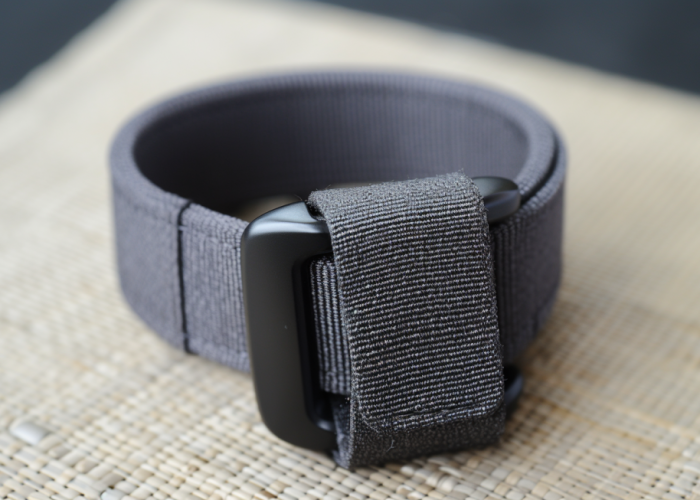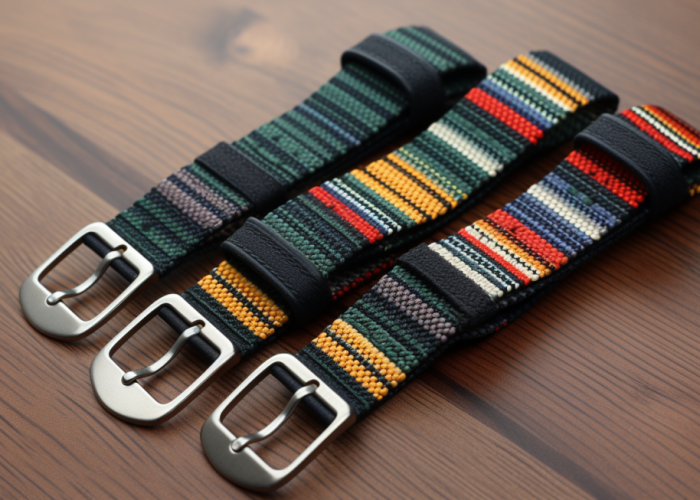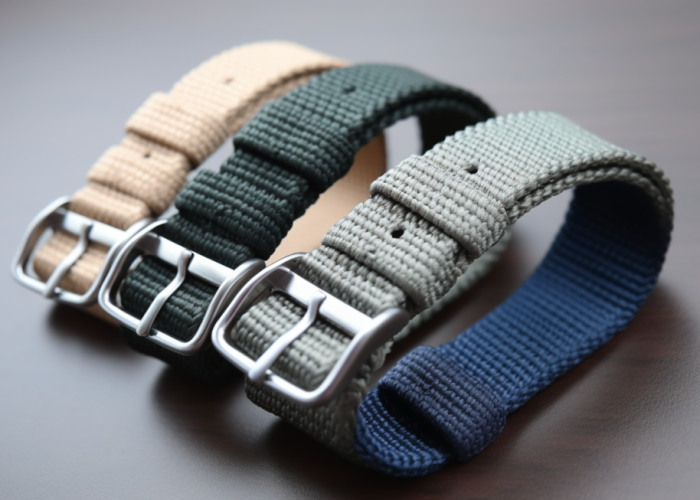Designing custom hook and loop watch straps requires balancing aesthetic appeal with functional durability. As experienced webbing manufacturers serving brand developers and product engineers, we’ve mastered the techniques that transform standard watch straps into distinctive brand assets through strategic material selection and precision customization.
Hook and loop watch straps can be customized by adjusting color, pattern, material, size, logo imprinting, hardware engraving, and comfort features. Options include embroidered logos lasting 10,000+ wear cycles and edge finishes that reduce skin irritation by 40%.
Explore detailed customization techniques, specs, and durability insights to help product developers create standout, high-performance watch straps.


Webbing manufacturing expert with 15+ years of experience helping product developers build high-performance straps for industrial, medical, and outdoor use.
The essential customization options for hook and loop watch straps include color selection, pattern application, material choice, branding elements, sizing specifications, and comfort features. Each option allows product developers to create distinctive designs that align with brand identity while maintaining functional durability. The most effective customizations balance aesthetic appeal with performance requirements for specific use cases.
Color selection forms the foundation of watch strap customization. We offer a wide range of colors and patterns to match specific brand identities and visual specifications. This includes options for solid colors, printed patterns, camouflage designs, and racing stripes that can be perfectly matched to your brand palette. Color customization extends beyond mere aesthetics, as certain color applications can enhance visibility in specific environments.
Pattern and material selection work hand-in-hand with color choices. Patterns such as carbon fiber, honeycomb, or racing stripes can be applied using advanced printing techniques that maintain durability even with extended wear. These patterns not only enhance visual appeal but can also signify specific product categories or target demographics. The material substrate itself must be carefully selected to balance the pattern application process with functional requirements, as certain patterns may require specific base materials for optimal adhesion and longevity.
Branding options elevate standard watch straps into branded accessories. We can apply your logo directly onto the strap using various techniques to create a cohesive brand experience. These branding elements can be positioned strategically on the strap to maximize visibility while maintaining comfort. Subtle embossing techniques can provide a premium feel, while vibrant color printing can create bold brand statements that capture attention.
The right material for a hook and loop watch strap depends on five key factors: durability requirements, comfort needs, environmental exposure, activity level, and brand positioning. Materials range from standard nylon with 5,000 wear cycle ratings to premium polyesters achieving 10,000+ cycles before degradation. High-performance applications may require specialized materials offering UV protection, water resistance, or antimicrobial properties.
Material strength represents the most critical factor in material selection. Priority should be given to materials that provide excellent abrasion resistance and controlled stretch. This ensures that the watch strap maintains its shape and functionality through extended use. The selected material must align with the intended use case, with options ranging from standard applications to extreme environments requiring specialized performance characteristics.
Edge protection significantly impacts both durability and comfort. Reinforced edges using techniques like ultrasonic cutting or specialized binding prevent fraying and increase the overall lifespan of the watch strap. Edge treatment options include heat sealing, binding tape application, and specialized edge coatings that enhance durability while maintaining a smooth feel against the skin.
Environmental considerations should guide material selection for specific applications. Exposure to elements like UV radiation, moisture, and temperature fluctuations can dramatically impact material performance. Materials can be selected with inherent resistance to these factors or treated with specialized coatings to enhance environmental protection. The intended use environment should always inform material selection decisions.

Sizing and fit options for hook and loop watch straps include customizable length, adjustable width designs, and specialized closure systems that accommodate a range of wrist sizes. Standard sizing typically ranges from 120mm to 240mm in length, with width options from 18mm to 26mm to match various watch cases. Custom sizing beyond these parameters is available for specific product requirements.
We can produce straps in precise length specifications to target specific user demographics. This includes shorter lengths for children’s products, standard adult sizing, and extended lengths for specialized applications such as over-wetsuit use. Each sizing variation maintains the same performance characteristics while optimizing fit for the intended user.
Width customization affects both aesthetics and functionality. Wider straps distribute pressure more evenly and can accommodate larger design elements, while narrower straps provide a more minimal appearance and reduce weight. The ratio between width and thickness must be carefully balanced to maintain structural integrity while achieving the desired visual profile.
Closure systems can be tailored to specific use cases. Traditional hook and loop systems offer infinite adjustability, while hybrid designs incorporating hardware elements provide additional security for high-stress applications. Fastening mechanisms can be engineered to accommodate specialized needs such as one-handed operation, enhanced security, or quick-release functionality.
Yes, Custom logos can be added to hook and loop watch straps through three primary methods: direct embroidery, digital printing, and heat transfer application. Each technique offers distinct advantages regarding durability, detail reproduction, and production efficiency. Logo placement is typically optimized for the visible portions of the strap while maintaining comfort against the wrist.
Direct embroidery provides exceptional durability for logos on watch straps. This method physically stitches your design into the webbing material, creating a textured, premium appearance that withstands washing and extended wear. Embroidery works best with simplified logos using limited color palettes and is ideal for branded products positioned in higher price segments where tactile quality reinforces perceived value.
Digital printing enables full-color reproduction with precise detail, making it suitable for complex logos or photographic elements. This technique offers excellent color matching capabilities for maintaining brand consistency across product lines. Digital printing works particularly well on smoother webbing materials and can achieve fine details down to 0.5mm resolution for intricate designs.
Heat transfer application combines durability with visual impact. This process permanently bonds your logo to the strap material through heat and pressure, creating a smooth finish that resists abrasion. Heat transfers can incorporate specialized effects such as metallic finishes, reflective elements, or dimensional textures that enhance brand recognition and product differentiation.

The best engraving methods for watch strap hardware include laser engraving, chemical etching, and mechanical engraving. Each technique provides different aesthetic results and durability profiles depending on the base metal and environmental exposure. Hardware engraving complements strap customization by extending brand identity to metal components while adding premium detailing.
Laser engraving offers precise detail reproduction on metal hardware components. This non-contact method creates permanent markings by vaporizing surface material with minimal impact on structural integrity. Laser engraving works effectively on stainless steel, aluminum, titanium, and plated surfaces, with resolution capable of reproducing fine text as small as 0.5mm height. The process creates contrast through depth rather than color, resulting in a subtle yet sophisticated appearance.
Chemical etching provides a distinctive textured finish with excellent wear resistance. This process uses controlled chemical reactions to remove material selectively from metal surfaces, creating recessed designs that can incorporate multiple depth levels. Chemical etching excels in creating decorative patterns across larger hardware surfaces and maintains its appearance through extended use without fading.
Mechanical engraving delivers a traditional, handcrafted aesthetic with pronounced depth. This process physically removes material using precision tools, creating deeply cut designs with tactile dimensions. Mechanical engraving is particularly well-suited for precious metals and high-end applications where traditional craftsmanship enhances product positioning.
The most secure attachment methods for hook and loop watch straps combine strategic fastener placement with reinforced connection points and supportive hardware elements. Security can be enhanced by implementing dual-layer closure systems, additional hardware anchoring, or specialized loop constructions that optimize tension distribution across the strap.
Hook and loop placement significantly impacts security and longevity. Optimal configurations position hook components to engage maximum loop surface area while minimizing edge exposure that could lead to premature detachment. We can engineer fastening zones with graduated hook density that creates progressive engagement, providing both security and comfort during active movement.
Hardware integration enhances attachment security for high-stress applications. Metal buckles, D-rings, or specialized connection points can be incorporated into the strap design to create redundant securing mechanisms. These hardware elements can be customized through material selection, finish treatment, and dimensional specifications to align with brand aesthetics while maintaining functional performance.
Fastening mechanisms can be tailored to specific activity profiles. Traditional hook and loop provides excellent general-purpose security, while hybrid systems incorporating snap closures or slotted connections deliver enhanced retention for high-impact activities. Each fastening system can be optimized through material selection and structural engineering to meet specific performance requirements.
Comfort features can be integrated into watch strap designs through cushioning materials, specialized edge treatments, breathable constructions, and ergonomic shaping. These elements enhance user experience by reducing pressure points, preventing skin irritation, and optimizing moisture management. Comfort features should be selected based on intended use duration, activity level, and environmental conditions.
Cushioning materials significantly improve wearability for extended use. Materials such as neoprene backing, microfiber linings, or contoured foam inserts can be laminated to the base webbing to create a softer interface with the skin. These materials distribute pressure evenly while providing thermal insulation in cold environments and moisture management in high-activity situations.
Edge finishing techniques prevent skin irritation while enhancing durability. Binding tapes, rolled edges, or heat-sealed perimeters create smooth transitions that eliminate abrasion points. These finishing methods can be color-coordinated with the main strap to create visual continuity or contrasting accents that highlight design features.
Breathable constructions optimize comfort in varied environmental conditions. Perforated sections, mesh inserts, or specialized weaving patterns create ventilation channels that manage moisture and heat. These features are particularly valuable for athletic applications or use in humid environments where moisture control impacts both comfort and hygiene.
Customizing hook and loop watch straps offers endless possibilities for product differentiation and brand expression. From material selection and logo application to hardware engraving and comfort features, each element can be precisely engineered to meet specific requirements. Our manufacturing expertise allows us to transform your concepts into premium, custom-branded watch straps that balance aesthetics, functionality, and durability for your unique market positioning.
Sizing specifications directly affect wearer comfort, security, and aesthetic proportions. We offer length customization from 120mm to 240mm and widths from 18mm to 26mm, with precise adjustments available for specific demographic targets. Custom sizing capabilities extend beyond standard parameters for specialized applications.
The most effective customization methods include color selection, pattern application, material specification, size adjustments, logo imprinting, hardware engraving, and comfort feature integration. We offer comprehensive solutions ranging from aesthetic modifications to technical performance enhancements, all customizable to your specific brand requirements.
Yes, we offer three distinct logo application methods: direct embroidery for textured durability, digital printing for complex color designs, and heat transfer for special finishes. Hardware components can be customized with laser engraving, chemical etching, or mechanical engraving depending on your desired aesthetic and performance requirements.
Durability is determined by base material selection, edge finishing techniques, fastener quality, and environmental protection treatments. Our engineering process optimizes these factors based on your intended use case, ensuring longevity through abrasion resistance, controlled stretch properties, and reinforced connection points.
Production timelines vary by customization complexity and volume. Digital printing typically requires 3-7 business days, embroidery 5-10 days, and heat transfers 4-8 days after design approval. Hardware engraving adds 2-4 days to the process. Rush processing options are available for time-sensitive product launches.
Strategic comfort enhancements include cushioning materials, specialized edge treatments, breathable constructions, and ergonomic shaping. These elements reduce pressure points, prevent skin irritation, and optimize moisture management, significantly improving user satisfaction and extended wear comfort in various environmental conditions.